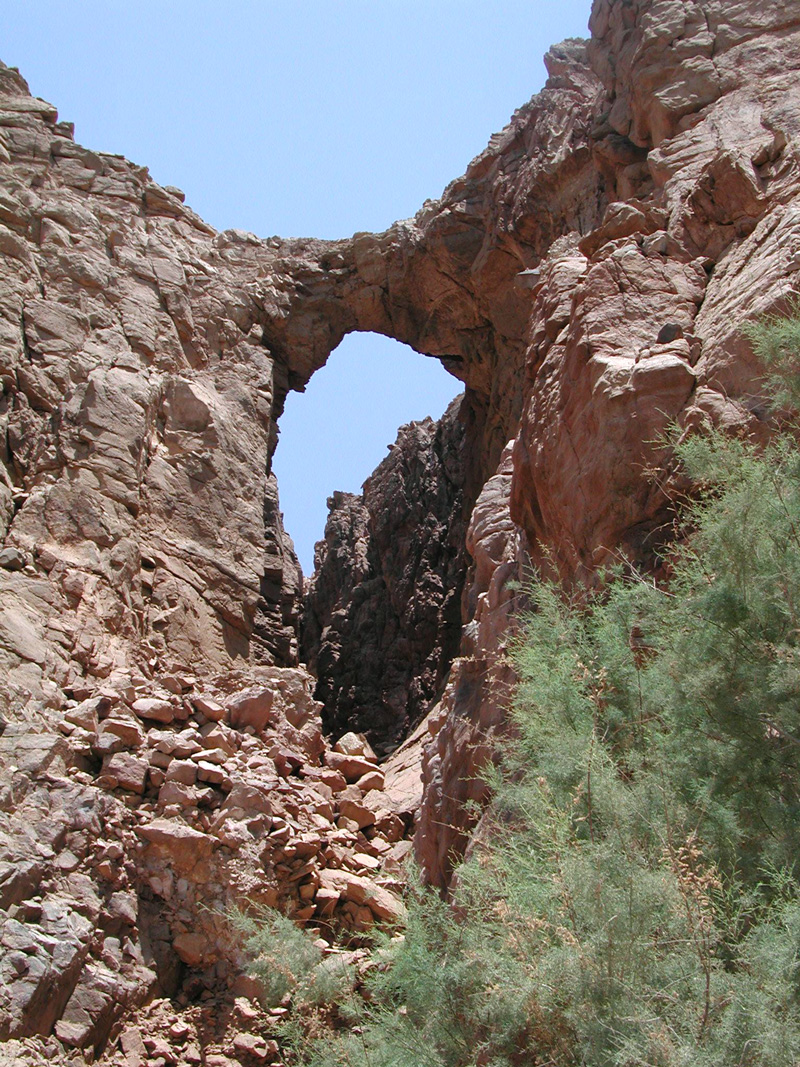Natural Bridge
One of the most dramatic landscapes of Jordan is the eastern shoreline of the Dead Sea. More than other parts around this lake, the eastern part stands like a wall, so close to the water, that it adds to the landscape a powerful contrast in color and texture, animating a wonderful line where mountains meet the sea.
The general redness of the mountainside, in the most vertical areas around the mouth of the Zarqa Ma’in and Mujib gorges, comes mostly from sandstone. One can notice the similarity of most of the sandstone of this area with that of Petra. Geologically speaking, the overwhelming stretch of sandstone you see here is of the same layer in which Petra was carved; the Um Ishrin Sandstone Formation. This layer is Jordan’s most colorful rock and it is easily recognized by its striped patterns that look like “raw beef” or wood-like grain on a larger scale.
Besides its brilliant colors and intricate striped patterns, this sandstone layer has a tendency to produce amazing rock formations, such as hanging canopies, geometric erosion patterns, and strange-looking pillars. In one location this layer has produced a natural bridge, similar to the more famous one in Wadi Rum but on a smaller scale.
In one of the narrow gorges, few kilometers south of the Mujib Bridge, this natural bridge spans a Siq-like gorge –its rocks form an arch giving the valley a monumental gateway. Natural arches happen when erosion cuts a gap in a softer or looser layer below a harder or more compacted one, keeping part of the original mountain formation spanned like a man-built arch. Jordan has at least three natural bridges of sizes significant enough to mention. Most people know the bridge (or bridges) at Wadi Rum. There is also an impressive natural bridge in Wadi al Himmeh to the northeast of Pella at the hot spring site of Himmet Abu Thableh, and this is the third bridge that can be added to the national collection.

Like an arched gateway in a sandstone wall, this bridge contributes an interesting feature to this rock layer. It is like a window in this giant wall of reddish sandstone 400 meters high. It hangs suspended spanning a fault-line, like a viaduct, in one of Jordan’s most seismically active spots, negotiating all of the frequent tremors and occasionally powerful earthquakes.
The eastern shore of the Dead Sea runs along an impressive section of Jordan’s geological layers, predominated by the Um Ishrin formation with its impressive lines in reds and purples. Driving along the coast, we can view the composition of this layer that was formed in the Cambrian period some 500 million years ago, when it was deposited by meandering rivers and braided streams.
Hidden in this landscape are countless natural and cultural attractions. There are wonderful trails passing water springs, ponds, hanging palm gardens, hot springs, waterfalls, volcanic landscapes, and many other features all waiting to be explored.
This coming winter, a treasure trove of many secrets tantalizes us to explore further.
Most of us drive to the hotels at the Dead Sea without paying much attention to the surrounding landscape. There are several hidden attractions in the steep eastern side of the Dead Sea basin, many easily discovered a short walk from the main road. A natural bridge can be found only few kilometers to the south of the Mujib gorge, in one of the smaller valleys. Its high location and the fact that its gorge is a narrow one, lacking the picturesque palms of other bigger valleys, makes this feature easily missed. The Dead Sea shore is a pleasant half-day destination. A full day can be more appropriate if one wishes to explore further sections of the mountainsides between the area of the hotels and the road to Karak. There is no need for 4x4 –a lot can be discovered not far from the main road.